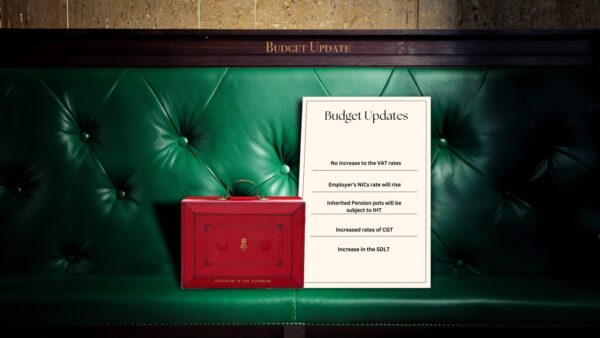Latest Posts

Autumn Budget 2024 – Key Private Client Changes
The Chancellor, Rachel Reeves, has delivered the 2024 Autumn Budget and is set to raise taxes by £40 billion. We summarise the key changes and when these are anticipated to come into force.
Stamp Duty Land Tax (SDLT)
- From 31 October 2024, there will be an increase in the SDLT rates for additional dwellings from 3% to 5%. These rates will apply to purchases of second homes and buy-to-let residential properties.
- The rate for corporate bodies and non-natural persons purchasing dwellings costing more than £500,000 will increase from 15% to 17%.
Value Added Tax (VAT)
- There will be no increase to the VAT rates which remain at 20%.
- From 1 January 2025, VAT will be applied to private education and boarding services. Additionally, from 6 April 2025 the charitable rate relief from business rates charged to private schools in England will be removed.
Income Tax
- There will be no changes to income tax or individual’s national insurance contributions (NICs).
- From 6 April 2026, carried interest will be taxed in line with income tax.
- From the 6 April 2025, Employer’s NICs rate will rise from 13.8% to 15% as well as the threshold at which NICs will become payable falling to £5,000.
Inheritance Tax (IHT)
- The inheritance tax thresholds of £325,000 (the nil-rate band) and £175,000 (the residence nil-rate band) will be fixed at the current rates for a further two years until April 2030.
- From 6 April 2027, inherited pension pots will be subject to inheritance tax.
- With effect from 6 April 2025, the scope of agricultural property relief (APR) will be extended to include land managed under an environmental agreement with, or on behalf of, the UK government, local authorities, or relevant approved bodies.
- From 6 April 2026, APR and business property relief (BPR) will be reformed. The existing 100% relief from IHT will continue to apply to the first £1 million of combined agricultural and business property. Thereafter, there will be a reduced rate applicable of 50%. A consultation is set to be published at the start of 2025 to explain how the reformed £1 million allowance will apply to qualifying assets that are held in trust.
- The rate of BPR will reduce to 50% in relation to shares designated as “not listed”, which includes AIM shares
Capital Gains Tax (CGT)
- The government has increased the lower rate of CGT from 10% to 18% and the higher rate from 20% to 24% for non-residential property disposals. This equalises the CGT rates with the current residential property CGT rates which remain unchanged. The CGT rate for trustees and Personal Representatives increases to 24%.
- Business Asset Disposal Relief (BADR) and Investors’ Relief are affected with BADR rising to 14% from 6 April 2025, and rising further to 18% from 6 April 2026. The lifetime limit on Investors’ Relief will be reduced from £10 million to £1 million on qualifying disposal made after budget day.
- From 6 April 2025, CGT charged on carried interest will increase from 28% to 32%. From 6 April 2026, a revised regime will be introduced to treat carried interest as trading profits therefore becoming subject to income tax as opposed to CGT.
Abolition of the Non-Domicile Regime
- The Government has committed to abolishing the historic non-domicile regime.
- A new regime, known as the Foreign Income and Gains regime (the FIG) will provide 100% relief on foreign income and gains for new arrivals to the UK in their first 4 years of tax residence, provided they have not been UK tax resident in any of the 10 consecutive years prior to their arrival.
- The concept of domicile will be replaced by a ‘residence’ test, based on the UK’s Statutory Residence Test.
- An individual is long-term resident (and in scope for Inheritance Tax on their non-UK assets) when they have been resident in the UK for at least 10 out of the last 20 tax years, and non-UK assets remain in scope for between 3 and 10 years after leaving the UK.
- A Temporary Repatriation Facility (TRF) will be available for individuals who have previously claimed the remittance basis.
- The TRF will be available for a limited period of three tax years at a reduced rate of 12% for tax years 2025/26 and 2026/27 and 15% in tax year 2027/28.
- The protection from tax on foreign income and gains arising within settlor-interested trust structures will no longer be available for non-domiciled and deemed domiciled individuals who do not qualify for the FIG.
- For Capital Gains Tax purposes, current and past remittance basis users will be able to rebase foreign assets they held on 5 April 2017 to their value at that date, when they dispose of them.
This is only a brief summary of the extensive changes that are coming into force. If you have any questions, please get in touch with the Private Wealth & Tax team at Quastels and we would be happy to assist.
Read More
Five Things To Do Before Selling A Flat
Thinking about selling your leasehold property? Here are five tips to kickstart your sale process.
1. Find Your Solicitor
The importance of finding your perfect match cannot be overestimated. The human factor is at the core of a seamless and transparent process. Good practice is to follow recommendations from friends and family (or your agent), review firm’s/lawyer’s website/profile, and of course compare quotes and establish the law firm’s usual response and transaction times. I would always recommend speaking with your solicitor prior to instructing them: a video call is a good starting point especially if you are based overseas.
2. Complete Your Client Onboarding
- If you are already an existing client with your chosen firm, this point may be ticked off already. If not, then make sure you complete your client onboarding in timely manner: provide your ID and proof of address (could be a utility bill or bank statement dated not less than three months from the point of submission).
- Have a look through your paperwork and data files: it is beneficial to provide various property documents which are in your possession to your solicitor at this stage too. These documents could be electrical installations certificates, Gas Safe certificates, NHBC, any planning or building documentation. This means that your solicitor will be able to provide these to the buyer’s solicitor with the initial contract pack, as opposed to raising with you at a later stage.
- If you have a mortgage, do provide your latest mortgage statement to your solicitor too, so that they liaise with your lender to obtain the up-to-date redemption figure (you will usually be redeeming your loan on completion).
3. Complete Your Leaseholder Deed of Certificate and Serve On The Landlord
If your property is a flat in a high-rise block, the recent legislation called the Building Safety Act 2022 (BSA 2022) will require you to serve a leaseholder deed of certificate (your solicitor will advise you, if required and will assist in preparing the document). The leaseholder deed of certificate is served on your landlord, and the landlord will in turn have four weeks to prepare their landlord’s certificate. The leaseholder deed of certificate will confirm whether your lease qualifies for protections under BSA 2022 (with respect to fire safety remediation works). It is therefore good practice to complete and serve the deed even before you have a buyer.
4. Complete Your Protocol Forms
Your solicitor will provide you with Law Society forms to complete and provide the relevant documentation referred to in the forms. These forms consist of standard questions about your property and must be completed by the seller. If you have questions on the forms, it is advisable to raise these at early stages of the sale process.
5. Last, But Not Least — Review and Confirm Your Timetable/Preferences With Your Solicitor and Estate Agent
Will you require a certain period between exchange and completion? Inform your lawyer at the start of the process. Would you prefer to exchange and complete on the same day? Your lawyer can propose this to the other side. Or are you planning an overseas trip, and your Internet connection may be on and off — do let your lawyer know beforehand, and we can make sure you sign sale paperwork before the trip, or agree digital signing with your buyer, not to delay the process. As always, communication is key, and this works both ways.
Sales and purchases are a stressful process but good preparation and working with a good team can ease the worry.
Nargiz Abdullayeva is a Senior Associate in our Residential Property Team. Nargiz has over 8 years of experience in high-value real estate transactions. To discuss any of the points raised in this article, please contact Nargiz Abdullayeva or fill out the form below.

Breaking Trusts Via a Common Intention
In the recent case of Nilsson and another v Cynberg [2024] EWHC 2164 (Ch) the High Court have confirmed that a common intention constructive trust (CICT) can vary an express declaration of trust.
What is a CICT?
These trusts are a method to determine beneficial ownership based on the intentions of the parties regarding the ownership of property even if those intentions were not formally documented.
There are two fundamental elements of a CICT being:
- There was an agreement or common intention as to an asset, which can be demonstrated either expressly or impliedly; and
- The intention was relied upon and one party has acted to their detriment on this basis.
Facts of Nilsson and Another V Cynberg [2024]
In 2001, Stuart Cynberg and Collette Cynberg purchased a property that they held on trust as beneficial joint tenants and they declared this to be the case in the TR1. Beneficial joint tenants means that both owners hold the equity in the property 100% indivisibly, such that the surviving tenant inherits the other share by survivorship. In 2006, the couple married and subsequently separated in 2009 at which time they discussed finances.
It was agreed by both parties that Mrs Cynberg would own the property solely, provided that she left the property to their children. As a result of the agreement, from 2009 Mrs Cynberg alone paid for all of the property expenses and also used money from her inheritance in 2014 for works on the property.
The couple then divorced in 2018, and shortly after Mr Cynberg was declared bankrupt in October 2018.
Mrs Cynberg sought declaratory relief, stating that she solely owned the beneficial interest in the property. She asserted that the agreement and discussions following their separation had given rise to a CICT or proprietary estoppel which in turn had varied the declaration of trust in the TR1.
The Trustees in Bankruptcy’s defence, however, was that the express declaration of trust was conclusive and could not be overridden by an informal agreement. Therefore, no CICT could have arisen and additionally there was no proprietary estoppel. Mr Cynberg had therefore retained a 50% beneficial interest in the property.
Legal Argument
In the first instance, the Judge declared that Mrs Cynberg was the sole beneficial owner.
This was appealed by the Trustees in Bankruptcy on four grounds. However, the following two grounds were of particular significance:
First Ground of Appeal
Required consideration of whether a “subsequent agreement” to vary an express declaration of trust must comply with the requirements of S.2 of the Law of Property (Miscellaneous Provisions) Act 1989 or whether a CICT sufficed.
The Deputy High Court Judge concluded that a subsequent agreement to vary is not limited to one that complies with statutory formalities and may include a CICT.
Second Ground of Appeal
The second ground was that the extent of detriment suffered by Mrs Cynberg was insufficient to give rise to proprietary estoppel.
The High Court held that taking over the mortgage payments all associated bills and the home improvements was sufficient detriment.
Courts Conclusion
The High Court dismissed all four grounds of appeal and upheld Mrs Cynberg as the sole beneficial owner.
Key Takeaways
This case is important as it adds to the case law supporting that an express declaration of trust can be varied by subsequent agreements including CICTs.
In practice, these cases turn heavily on the facts particularly that in addition to providing evidence that there was a common intention, it must be demonstrated that an individual has acted to their detriment in reliance of the intention.
Constructive trusts are a complex area and if you are concerned about any such variation we recommend that all agreements/variations are formally documented.
If you have any queries relating to this topic, please contact Ben Rosen or Eleanor Catling at Quastels LLP.